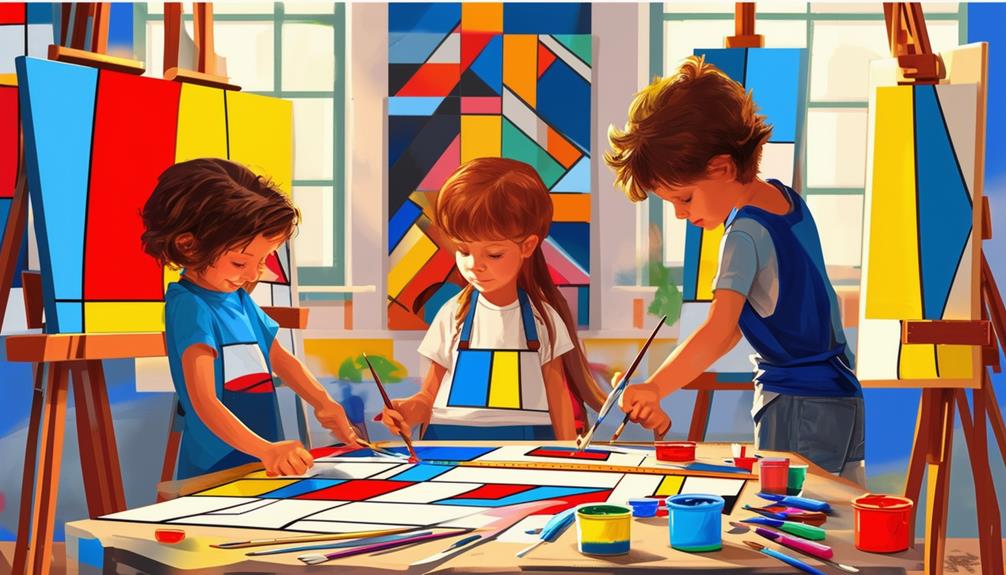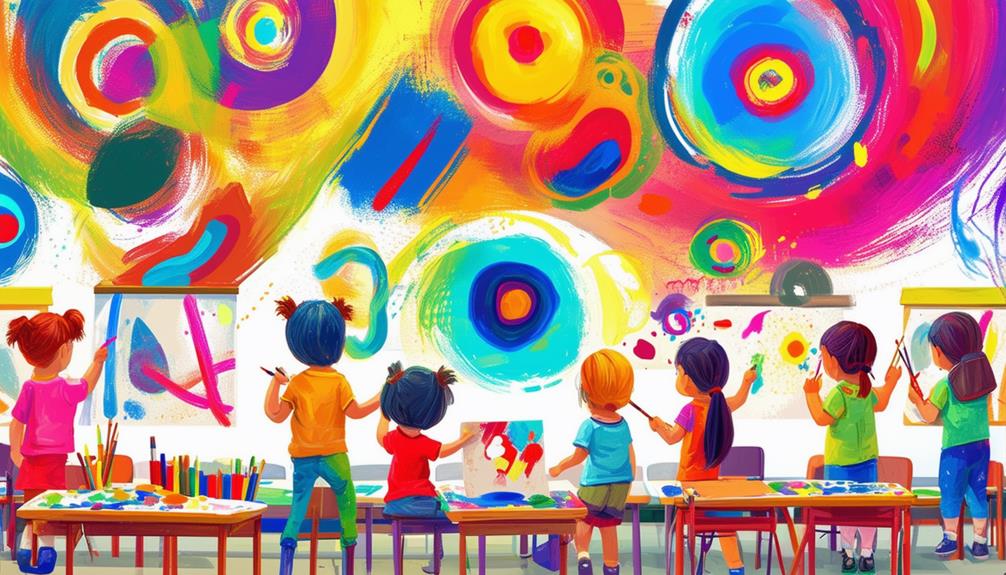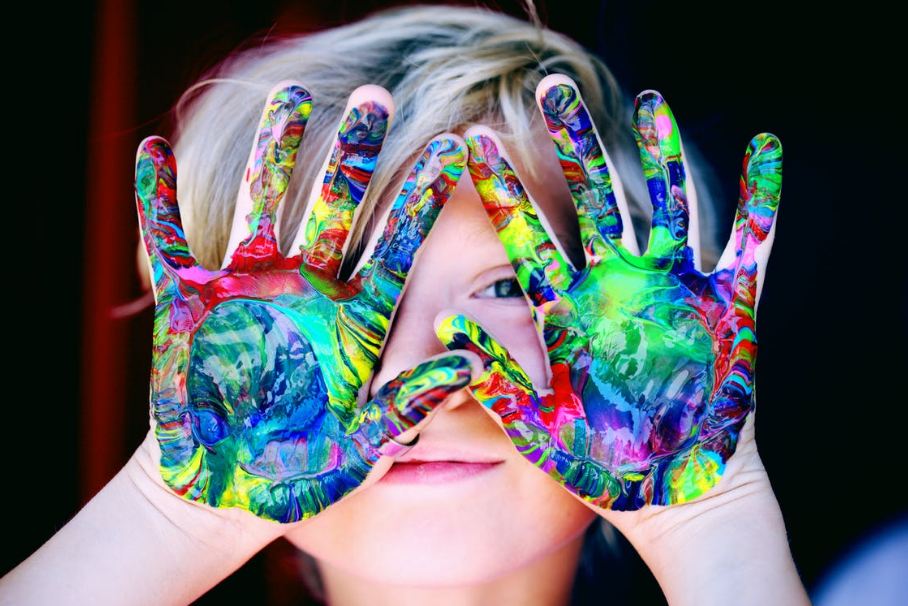Teaching Kids About Famous Artists Through Painting Projects

Introducing kids to famous artists through painting projects can effectively spark their interest in art history and foster creative expression. Guiding them in creating Picasso's Cubist portraits or Warhol's pop art prints not only teaches them about iconic styles but also encourages their own artistic exploration. Imagine the excitement of a child replicating Mondrian's geometric designs or experimenting with Kandinsky's abstract shapes. These projects can significantly influence a child's perception of art and creativity, promoting a deeper appreciation and understanding of diverse artistic techniques. Additional benefits of such hands-on learning experiences include improved fine motor skills, enhanced problem-solving abilities, and increased cultural awareness.
Picasso's Cubist Portraits
When teaching kids about Picasso's Cubist portraits, show them how he revolutionized art by depicting subjects from multiple viewpoints simultaneously. Begin by explaining how Picasso deconstructed forms into geometric shapes and reassembled them into abstract compositions. His Cubist portraits, especially his self-portraits, serve as excellent examples to illustrate this concept.
Encourage kids to create their own Cubist-inspired portraits. Have them use geometric shapes and bold colors to capture different perspectives within a single piece. This hands-on activity helps them grasp how Picasso conveyed complex perspectives and abstraction in his work.
Another engaging project is exploring Picasso's "Three Musicians" collage. This piece exemplifies his innovative collage technique and abstract style. Guide kids in creating their own collages using diverse materials, focusing on the use of geometric shapes to form abstract compositions. This will foster their artistic expression and understanding of perspective.
Warhol's Pop Art Prints
Dive into the vibrant world of Andy Warhol's Pop Art Prints, where everyday objects and celebrities become the stars of striking, colorful compositions. Warhol revolutionized the art scene by blending high art with pop culture, making it accessible to everyone. His iconic works, such as the Marilyn Monroe Diptych and Campbell's Soup Cans, exemplify his fascination with consumerism and celebrity culture.
When introducing kids to Warhol's Pop Art, you can ignite their creativity and individuality. Start by explaining how Warhol's use of bold patterns and repetition made ordinary items iconic. Engage them in Warhol-inspired activities, such as creating their own pop art portraits or experimenting with printmaking techniques. These art projects will not only familiarize them with Warhol's style but also encourage them to think outside the box.
Incorporate hands-on activities to make the learning experience memorable. Have kids create prints using simple materials like potatoes or foam sheets. Let them choose everyday objects or famous figures to depict in their artwork, mirroring Warhol's approach. By doing so, you'll inspire a new generation to appreciate and explore the endless possibilities within the realm of Pop Art.
Mondrian's Geometric Designs

When teaching kids about Mondrian's geometric designs, start by exploring primary colors and their role in creating vibrant compositions. Encourage them to use red, yellow, and blue within simple geometric shapes to understand pattern and balance. By focusing on straight lines and grids, they will learn about abstraction and harmony in art.
Primary Color Exploration
Exploring Piet Mondrian's geometric designs offers a fun and educational way to introduce kids to primary colors and abstract art. Mondrian, a renowned artist, used the primary colors—red, blue, and yellow—alongside black lines and white spaces to create striking abstract compositions. By examining his art style, children can engage in hands-on activities that enrich their understanding of primary colors and geometric designs.
Begin by discussing how Mondrian's use of lines and shapes formed the foundation of his abstract compositions. Explain that his art focused on simplicity and balance, using only the three primary colors. Then, encourage the kids to create their own Mondrian-inspired art projects. Provide them with materials like colored paper, markers, or paint in red, blue, and yellow, and let them experiment with forming their own geometric patterns.
These activities offer a valuable opportunity for color exploration. Kids will learn how different colors interact and how simple shapes can create visually appealing designs. Through these hands-on projects, they'll gain a deeper appreciation for Mondrian's unique approach and the broader concept of abstraction in art.
Geometric Shape Patterns
To explore Mondrian's geometric designs, start by examining how he utilized straight lines and primary colors to create harmonious compositions. Mondrian's art style, known as neoplasticism, aimed to express universal harmony and order through geometric shapes. By using intersecting angles and straight lines, he crafted balanced patterns that teach fundamental design principles and color theory.
Creating Mondrian-inspired art is an excellent way for kids to understand these concepts. Using rulers to draw precise lines and arranging colored shapes helps them appreciate the beauty and simplicity of geometric patterns. Here's a simple guide for your Mondrian-inspired project:
| Step | Description |
|---|---|
| 1. Gather Materials | Collect paper, a ruler, a black marker, primary colors (red, blue, yellow), and a pencil. |
| 2. Draw Lines | Use the ruler and pencil to draw straight lines on the paper, ensuring they intersect at right angles. |
| 3. Trace Lines | Go over the pencil lines with a black marker. |
| 4. Add Colors | Fill in the shapes with primary colors, leaving some areas white for contrast. |
This exercise helps children grasp fundamental design principles and color theory while appreciating the simplicity and elegance of geometric patterns.
Klimt's Golden Trees
When introducing children to Klimt's 'Golden Trees,' you'll captivate them with his decorative style and the enchanting Tree of Life motif. Encourage them to observe how Klimt's use of gold and intricate patterns brings the natural world to life. This exploration can inspire young artists to experiment with mixed media and appreciate the beauty of nature in their own creations.
Klimt's Decorative Style
Gustav Klimt's decorative style, particularly exemplified in his 'Tree of Life,' captivates with its intricate patterns, gold leaf, and rich symbolism. Klimt's fusion of realism and decorative elements is truly remarkable. His 'Tree of Life' not only showcases his mastery of detailed patterns but also his innovative use of gold leaf, lending a luxurious touch to his pieces. The incorporation of geometric shapes and vibrant colors creates a striking contrast that draws viewers in, while the deep symbolism in his work offers layers of meaning.
Introducing students to Klimt's ornate aesthetic can be achieved by encouraging them to create Klimt-inspired projects. Using materials like metallic beads, sequins, and gold accents can help replicate the opulence of Klimt's works. This hands-on approach makes it easier for kids to appreciate the complexity and beauty of his decorative style. By exploring Klimt's 'Tree of Life,' students gain valuable insights into art history and decorative arts, learning to balance realism with decorative flair. This project not only teaches technical skills but also inspires creativity, making art history both educational and enjoyable.
Tree of Life
Klimt's 'Tree of Life,' celebrated for its intricate detail and symbolic depth, stands as a testament to his unique artistry and vision. This iconic painting, adorned with gold and swirling patterns, symbolizes life, connection, and the cycle of existence. Introducing children to Gustav Klimt's 'Tree of Life' through art projects can spark creativity and deepen their understanding of art history.
Encourage children to recreate this masterpiece using metallic beads, sequins, glitter, and vibrant colors. These materials capture the painting's shimmering effect and make the project engaging and fun. As they place each bead and sequin, kids refine their fine motor skills and explore Klimt's symbolic elements.
Discuss with them how the tree's branches represent growth and connection, emphasizing the painting's deeper meanings. This hands-on activity fuels their creativity and instills an appreciation for Klimt's unique style and thematic depth. By the end, they'll have a stunning piece of art and a newfound respect for one of art history's most famous paintings. Integrating Klimt's 'Tree of Life' into your lesson plan makes learning about art both meaningful and memorable.
Kandinsky's Abstract Shapes

Kandinsky's abstract shapes invite children to explore a vibrant world of colors and geometric forms, sparking their creativity and emotional expression. By engaging with Kandinsky's unique style, children can learn how abstract shapes and concentric circles convey profound emotions. His use of bold color combinations and circular patterns offers a playful and creative avenue for kids to experiment with their artistic abilities.
Encourage children to use free-flowing shapes that don't adhere to strict forms. Show them how the power of color can transform a basic shape into something that conveys joy, excitement, or calmness. It's captivating to watch how kids react to the freedom of mixing and matching colors, creating their own interpretations of Kandinsky's vibrant art.
Start with a simple project involving concentric circles. Have the children choose their favorite colors and create layers of circles, experimenting with different sizes and shades. This enriches their understanding of geometric forms and demonstrates how different color combinations can evoke diverse emotions. Through these activities, children will gain a deeper appreciation for the emotional impact of abstract art.
Van Gogh's Starry Nights
Van Gogh's "Starry Night" captivates with its swirling patterns, bold colors, and expressive brushstrokes, inviting viewers to experience the night sky through his eyes. Created in 1889 while Van Gogh stayed at an asylum in Saint-Rémy-de-Provence, France, this iconic work has become a cornerstone in art history. It serves as an excellent subject for teaching children about famous artists through engaging art projects.
To introduce kids to Van Gogh's technique, you can use oil pastels to mimic his style. Focus on the swirling patterns and expressive brushstrokes that define "Starry Night." This project not only familiarizes children with Van Gogh but also encourages them to create their own inspired art.
Here's a simple guide to the project:
| Step | Materials Needed | Instructions |
|---|---|---|
| 1 | Oil pastels | Choose dark blue paper for the night sky. |
| 2 | Pencil | Lightly sketch the main elements: stars, moon, and swirling clouds. |
| 3 | Oil pastels | Fill in the sketch using bold colors, focusing on swirling patterns. |
| 4 | Oil pastels | Add expressive brushstrokes to give movement and life to the painting. |




